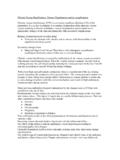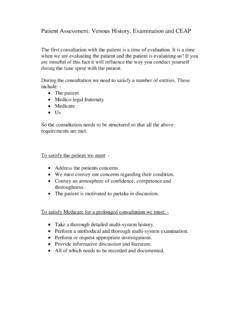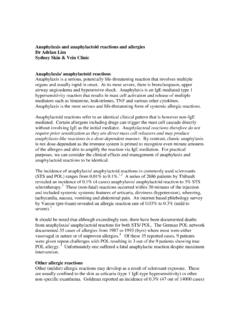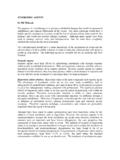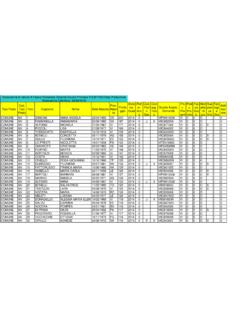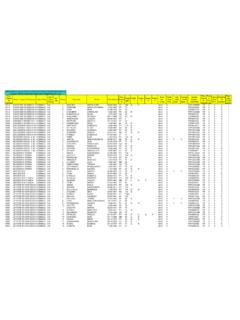Transcription of Anatomy & Physiology of the Peripheral Venous …
1 Anatomy & Physiology of the Peripheral Venous System By: Dr Peter Paraskevas Main Physiological Functions Return of Venous Blood back to the Heart Thermoregulation Storage of blood 70% of blood stored in the Venous system Regulation of cardiac output Thermoregulation Vasoconstrictor fibres supply the SVS Heat response: Removal of vasoconstriction Cooler blood diverted towards skin helping in heat dissipation Cold response: Constriction of arterioles and superficial veins This allows heat conservation by diverting Venous blood through the perforators into the deep veins which lie closer to the arteries The Physiology of Venous Return As arterial blood flows into the leg, distal superficial veins constantly fill Venous Blood is regularly emptied from the superficial system into the deep Venous system via the SFJ, SPJ and perforators This blood is then returned to the right side of the heart through one-way valves by calf muscle contraction.
2 Venous Return occurs uphill against gravity, against fluctuating thoraco-abdominal pressures and sometimes in the face of additional back-pressures such as CCF. The process of Venous Return depends on the patency of the flow circuit and on the normal functioning of the Calf Muscle Pump and Venous Valves Valvular System One-way , Bi-cuspid These valves permit blood flow from superficial to deep (foot is only exception) and from distal to proximal Located every few centimeters in veins below the CFV Located in Perforators and at Major Junctions (SFJ, SPJ) Made up of thin sheets of collagen/smooth muscle, covered by endothelium Calf Muscle Pump and Ambulatory Venous Pressure (AVP) When calf muscles are at rest, deep veins expand and blood is drawn in from the superficial veins. Venous Refilling occurs via arterial inflow (VRT 25-30 s). Normal Resting Supine Venous Pressure in the foot is approximately 80-100 mmHg.
3 With calf-muscle contraction, blood is forced up the deep veins Foot Pump also contributes. The immediate post-AVP is about 20% of the resting supine Venous pressure. Venous Pathophysiology Chronic Venous Insufficiency is caused by either impaired Venous outflow or abnormal (retrograde) Venous inflow. Chronic Venous Hypertension occurs when the AVP is persistently elevated Exercise can no longer empty the leg of blood and thereby decrease AVP. Failure of this normal process, leads to a persistently elevated Venous pressure despite ambulation. This subsequently results in Chronic Venous Hypertension. Any condition that increases Venous inflow or impedes Venous outflow will result in a persistently elevated Venous pressure during or immediately after ambulation. Calf Muscle Pump Failure CMP failure leads to incomplete emptying of Venous blood from the leg and hence an increase in post AVP Muscle Atrophy - bed rest and immobility (plaster casts) - muscle injury - deliberate dieting, malnutrition, malabsorptive states, eating disorders - Neuromuscular causes neuropathies, MND, nerve injuries, neuralgias - Malignancy (pancreatic, stomach, lung, ) - Chronic Infection (HIV, TB) - CCF - Endocrine Causes (Hyperthyroidism, Addisons, Cushings) - Arthritic (OA, Rheumatoid) - Seven Masquerades (Depression, Diabetes, Drugs, Anaemia, Thyroid, ) Prolonged Standing Deep Venous Obstruction Thrombotic - Spontaneous - Induced - Hereditary - Acquired Non-thrombotic - Diaphragm-like membrane (Kilken et al, 2004)
4 - Fibrous Tissue compressing DVS (KTS) - Tumour 1. Mesenchymal Chondrosarcoma (Kim et al., 2003) 2. Primary Venous Leiomyosarcoma (Zhang & Wang, 2006) 3. Primary Malignant Lymphoma (Rulli et al., 2002) 4. Popliteal Vein Compression Valvular Incompetence Deep Incompetence - primary valve agenesis (?KTS) - Prior Valve damage - direct trauma - dilation with 2ndary valve failure Perforator Incompetence - trauma - secondary to deep vein obstruction Superficial Incompetence Valve Failure - Gravitational Hydrostatic Pressure (prolonged standing) - Congenital Weakness of valves - thrombophlebitis - trauma - hormonal influences Superficial Venous System Great Saphenous Vein Originates in Medial Foot as part of dorsal Venous arch Continues proximally , along the medial aspect of the foot as the medial marginal vein of the foot GSV then passes anterior to the medial malleolus Ascends along the tibial edge of the medial calf to cross the knee.
5 Lies within a fascial compartment (not as large and well defined as in the thigh) From the upper calf to the groin, the GSV lies within a very clearly defined fascial compartment (superficial and deep fascial fascia) known as the saphenous eye . Typical normal GSV is 3-4 mm in diameter Usually has 10-20 valves Saphenous Nerve and it s association with the GSV Very close association with the Saphenous Nerve , in the lower leg, which may be injured during surgical stripping/EVLT/UGS Saphenous Nerve is the largest branch of the Femoral Nerve and is purely sensory, supplying the anteromedial and posteromedial aspects of the lower leg. Sapheno-Femoral Junction The GSV terminates into the SFJ (a short segment that receives multiple tributaries) There is a constant terminal valve 1-2 mm distal to the termination of the GSV There is a preterminal valve a further 2 cm distal which marks the distal area of the SFJ this is the upper limit for EVLT.
6 GSV Tributaries Anterior Accessory Saphenous Vein Posterior Accessory Saphenous Vein (PASV) Anterior Thigh Circumflex Vein (ATCV) Posterior Accessory GSV of leg (aka Posterior Arch Vein) Anterior Accessory GSV of leg Communicating Branch with SSV, usually via another tributary. Small Saphenous Vein Drains the Postero-Lateral Aspect of the Leg and lateral aspect of the foot. Originates in the lateral foot as part of the dorsal Venous arch. Ascends proximally behind the lateral malleolus as continuation of lateral marginal vein of foot Frequently terminates at the popliteal vein, but this may vary. The SSV lies for its entire length in an inter-fascial compartment defined by the deep muscular fascia and superficial fascia. The distal compartment appears on ultrasound as an Egyptian eye The proximal compartment is defined by the medial and lateral heads of gastrocnemius and the superficial fascia Sural Nerve intimately associated in distal 1/3 Medial Cutaneous Sural nerve in upper 2/3s 9-12 valves Sural Nerve and its association with the SSV Sural Nerve is formed in the distal portion of the leg by the union of the Medial Sural Cutaneous Nerve (branch of tibial nerve) and a Peroneal Communicating Branch.
7 In 20%, the peroneal communicating branch may be absent. The Lateral Sural Cutaneous Nerve may also contribute. Although the sural nerve is considered to be a sensory nerve, motor fibres have been found in of cases. (Amoiridis G, Schols L, Ameridis N, Przuntek H. Motor fibers in the sural nerve of humans. Neurology 1997;49:1725-8) The Sural Nerve is intimately associated with the SSV in the distal calf. It lies lateral to the SSV in the distal leg. Injury to the sural nerve following surgery can cause permanent lateral leg/foot paraesthesia Care must also be taken with EVLT in the lower third of the leg. Thigh Extension of the SSV Confirmed by ultrasound Present in 95% of limbs Lies deep to the fascia of the posterior thigh 4 distinct patterns 1. Continue as single vein to the Gluteal area 2. Join FV via post. or perforator 3. Divide into many muscular or s/c branches 4.
8 Connect to the PTCV which then connects to the GSV. This complex of veins (TE + PTCV) is termed Giacomini Vein. Termination of the SSV 3 possible variations 1. SSV joins popliteal vein at the SPJ, joins deep veins at higher level via TE, or joins GSV via Giacomini 2. SSV continues as TE/Giacomini but communicates with popliteal vein via small anastamosis 3. There may be no connection to the popliteal or deep veins. Hence, SSV continues as TE or Giacomini Vein Sapheno-Popliteal Junction Position of the SPJ is highly variable Most often situated within 2-4 cm above the knee crease, but above this level in 25% SSV joins popliteal vein from the posterior aspect in 15%, postero-medial in 30%, lateral in 42% and antero-lateral in 1% Terminal SSV has a terminal valve in close proximity to the popliteal vein and a pre-terminal valve just below the depart of the TE of the SSV Tributaries of the SSV Subcutaneous tributaries pierce the superficial fascia Common tributary seen on regular U/S is the so called popliteal fossa perforating vein.
9 First described by Dodd Runs s/c along of calf and popliteal fossa, sometimes parallel to SSV Typically forms a separate junction with the popliteal vein, usually lateral to the SPJ Communicating branch with GSV or its tributaries Lateral Venous System aka Lateral Subdermic Venous System or Albanese system May represent the remnant of the embryonic lateral marginal vein Extremely common and accounts for large % of phlebologist s practice Normal flow is paradoxically downwards from proximal thigh into lateral thigh and lateral knee perforators. Reflux commonly occurs via these perforators Small percentage occur via incompetent ATCV/GSV Perforators Perforators act as alternative pathways from superficial to deep They pass through anatomical defects in the deep fascia and join directly with deep veins of the thigh or calf They usually contain one way bicuspid valves that allow blood flow from superficial to deep All perforators are accompanied by an artery GSV System Perforators Perforators of the femoral canal (formally Dodd) connect the GSV to the Femoral Vein.
10 Para-tibial Perforators (formally Sherman in the lower and mid leg and Boyd in the upper leg) connect the GSV or its tributaries to the Posterior Tibial Veins. Posterior Tibial Vein Perforators (formally Cockett s) are divided into upper, middle and lower and connect the Posterior Arch Vein to the Posterior Tibial Veins. Anterior Leg Perforators (pierce the Anterior Tibial compartment to connect the ant. GSV tributaries to the anterior tibial veins. SSV System Perforators Soleal Perforators perf. of May Para-Achillean Perforators perf. of Bassi Deep Veins of the Calf Intra-muscular ( Venous sinusoids within the corresponding muscle, coalesce to form these veins. In most cases, these are paired and run with a corresponding artery) - soleal, gastrocnemius Inter-muscular veins (these veins are all paired and run with their accompanying artery) - peroneal, post.)
